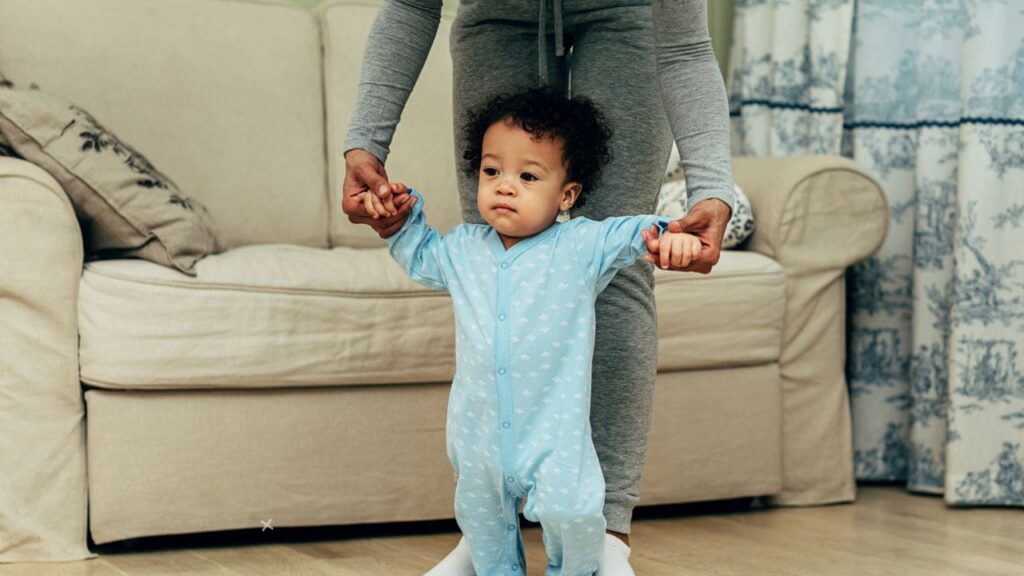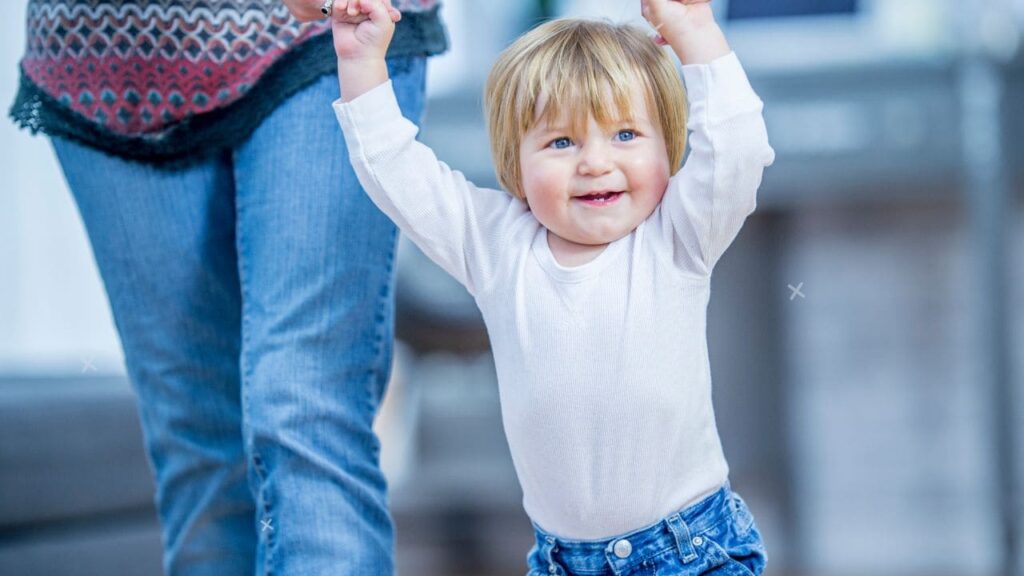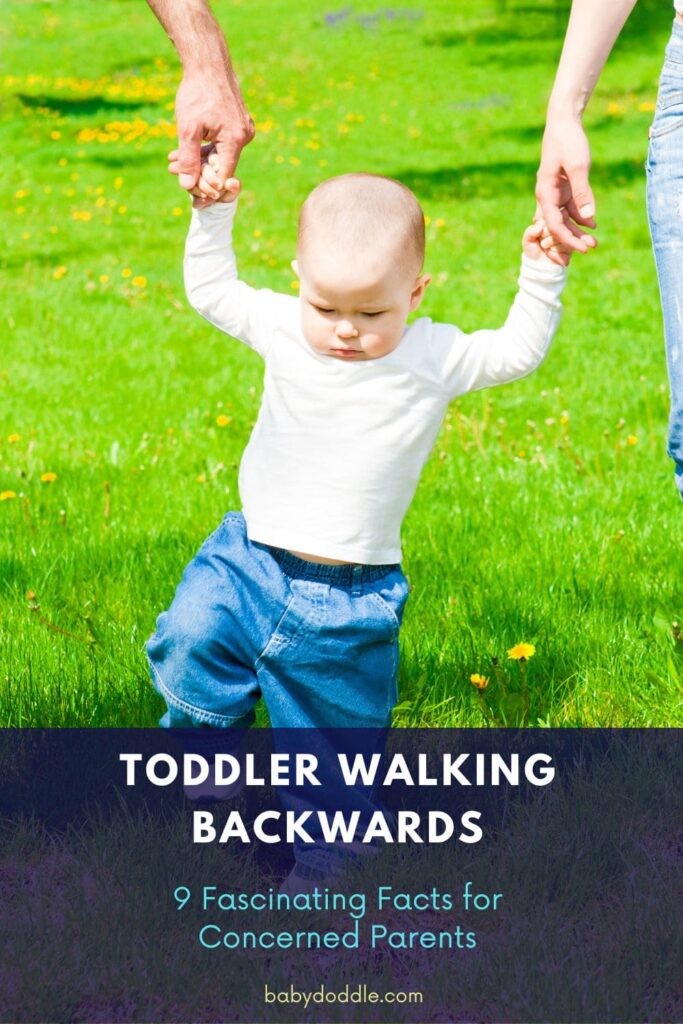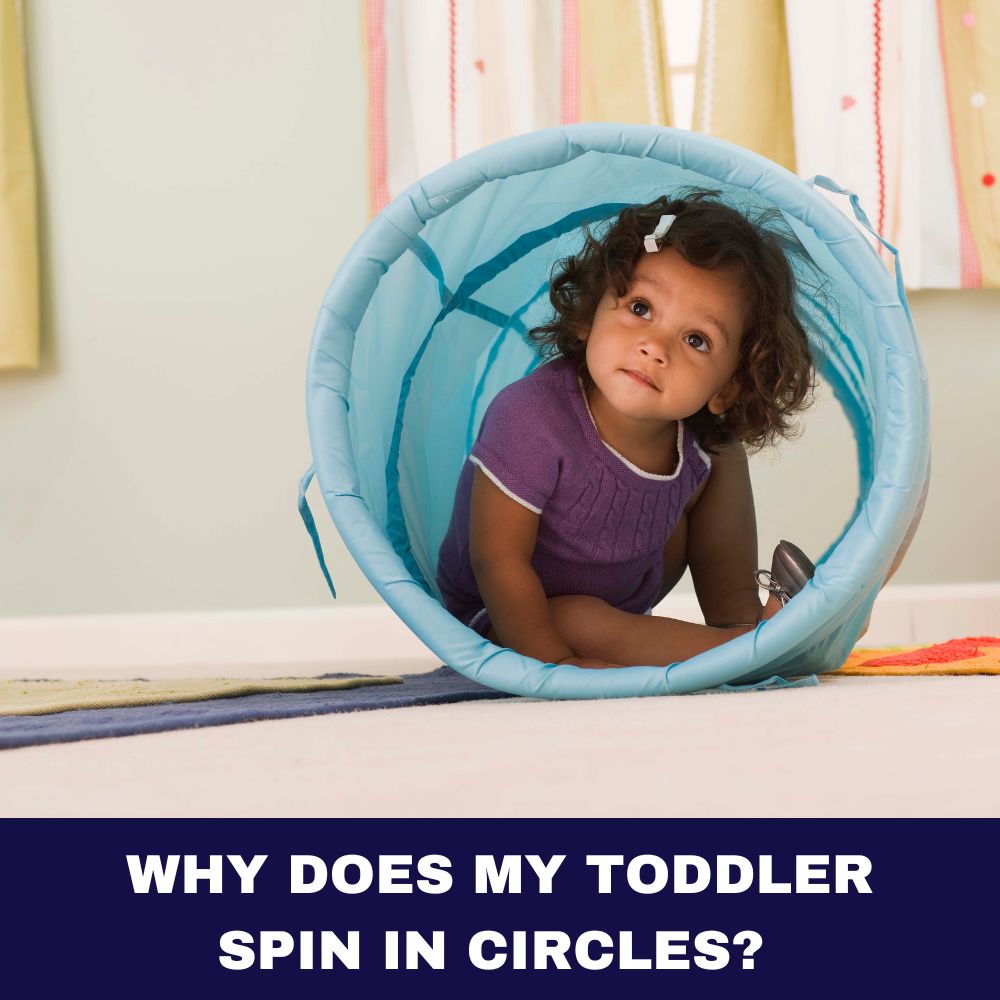Ah, the joys of parenthood! Just when you think you’ve got a handle on things, your little one throws you a curveball. One day, they’re taking their first tentative steps, and the next, they’re walking backward like a seasoned crab. If you’re a first-time parent, this sudden shift in direction might leave you scratching your head, wondering if something’s amiss with your child’s development.
Fear not, dear parents! Toddlers walking backwards is not only completely normal but also a fascinating phase in their growth journey. In this blog post, we’ll explore nine fascinating facts about this quirky phenomenon, providing you with a deeper understanding and offering reassurance to any concerned parents out there.

| Age Range | Milestone |
|---|---|
| 8-10 months | Pulling up to stand, cruising along furniture |
| 10-12 months | Taking first steps independently |
| 12-15 months | Walking more steadily, improving balance |
| 15-18 months | Walking backwards, side-stepping, turning |
| 18-24 months | Running, climbing, and navigating obstacles |
The Science Behind Backward Walking
Toddlers’ fascination with walking backwards is not just a phase; it’s a manifestation of their innate drive to explore and understand the world around them through movement. From a scientific perspective, this behavior is closely tied to their developing vestibular system, which is responsible for maintaining balance and spatial orientation.
As toddlers walk backwards, they engage different muscle groups and neural pathways, stimulating the vestibular system and enhancing their proprioceptive awareness (the ability to sense the position and movement of their body in space). This process helps them build stronger connections between their sensory inputs and motor outputs, laying the foundation for more advanced physical skills and coordination later on.
In fact, research has shown that toddlers who engage in more diverse movement patterns, including walking backwards, tend to have better overall motor skill development and balance compared to those who primarily walk forwards.
1. It’s a Natural Part of Gross Motor Skill Development
Toddlers are like tiny explorers, constantly discovering new ways to navigate their world. Walking backwards is a natural part of their gross motor skill development, as they experiment with different movement patterns and strengthen their balance and coordination.
Think of it like learning to ride a bike – you might wobble a bit and even pedal backwards before you get the hang of it. Similarly, toddlers are mastering the intricate art of bipedal locomotion, and walking backwards is simply one step (or perhaps a step back) in that process.
2. It Helps Develop Spatial Awareness
Have you ever tried walking backwards? It’s not as easy as it seems, is it? Well, for toddlers, this seemingly simple act is an excellent way to develop their spatial awareness and depth perception.
By moving in reverse, toddlers are forced to pay closer attention to their surroundings, strengthening their ability to gauge distances and navigate obstacles. This spatial awareness is crucial not only for their physical development but also for their cognitive growth, as it lays the foundation for more complex problem-solving skills down the road.
Next Step Advice: Encourage your toddler’s spatial awareness by creating a safe, obstacle-filled environment for them to explore. Set up cushions, boxes, or even a small play tunnel – anything that challenges them to navigate their surroundings while walking backwards.
3. It’s a Sign of Curiosity and Exploration
Ever wondered why your toddler seems so fascinated by the world behind them? Well, it’s because walking backwards allows them to explore their environment from a whole new perspective.
Toddlers are naturally curious little beings, and walking backwards is just one way they satisfy that insatiable thirst for discovery. By retracing their steps, they can observe familiar spaces with fresh eyes, noticing details they might have missed before.
So, while it might seem like a quirky behavior, their backward strolls are actually a testament to their inquisitive nature and desire to learn about the world around them.
Next Step Advice: Nurture your toddler’s curiosity by engaging them in sensory activities that stimulate their senses. Set up a texture board with different materials, or create a scavenger hunt around the house, encouraging them to explore and discover new things along the way.
4. It Improves Balance and Coordination
Walking backwards might seem like a surefire way to trip and fall, but for toddlers, it’s actually an excellent exercise in improving their balance and coordination.
When walking backwards, toddlers must engage different muscle groups and rely more heavily on their vestibular system (the system responsible for maintaining balance and spatial orientation). This added challenge helps strengthen their core muscles, improves their posture, and enhances their overall coordination.
It’s like a mini workout for their developing bodies, preparing them for more complex physical activities down the line.
Next Step Advice: Encourage your toddler’s balance and coordination by setting up simple obstacle courses or balance beams (use cushions or blankets to create a safe surface). You can also try playing catch or rolling a ball back and forth, which will challenge their coordination and body control.
5. It’s a Temporary Phase
While it might seem like your toddler will be walking backwards forever, this phase is actually quite temporary. Most toddlers start walking backwards around 12 to 18 months of age, and the behavior typically lasts for a few weeks to a couple of months.
As they gain more confidence in their forward mobility and their gross motor skills continue to develop, the backward walking will gradually taper off. Before you know it, they’ll be running circles around you (quite literally), leaving their backward days behind.
Next Step Advice: Embrace this fleeting phase and document it with photos and videos. Trust us, you’ll look back on these quirky moments with fondness and laughter once your little one has mastered the art of forward motion.

6. It’s a Gateway to More Complex Movement Patterns
While walking backwards might seem like a simple (albeit unconventional) movement, it’s actually a gateway to more complex physical abilities.
As toddlers explore this reverse motion, they’re laying the foundation for skills like side-stepping, turning, and even dancing. These more advanced movement patterns require a level of body control and spatial awareness that walking backwards helps cultivate.
So, while it might seem like a quirky habit now, your toddler’s backward strolls are setting the stage for future physical prowess and coordination.
Next Step Advice: Encourage your toddler’s movement exploration by playing music and encouraging them to dance or move in different directions. You can also introduce simple games like “Red Light, Green Light” or “Simon Says,” which will challenge their ability to switch between different movements and follow instructions.
7. It’s a Way to Gain Independence and Confidence
Toddlerhood is a time of burgeoning independence and self-discovery. Walking backwards is just one way toddlers assert their newfound autonomy and build confidence in their physical abilities.
By mastering this unconventional movement, toddlers are essentially saying, “Look at me! I can do this all by myself!” It’s a small but significant step towards gaining independence and self-assurance.
So, while it might look a little silly to us adults, walking backwards is a source of pride and accomplishment for your little one.
Next Step Advice: Celebrate your toddler’s achievements, no matter how small. Praise them when they successfully navigate a new obstacle or navigate a tricky terrain while walking backwards. This positive reinforcement will boost their confidence and encourage them to keep exploring and pushing their limits.
8. It’s a Sign of Healthy Development (Most of the Time)
In most cases, toddlers walking backwards is a perfectly normal and healthy part of their development. However, there are a few instances where it might be a cause for concern.
If your toddler seems to be walking backwards more than forwards, or if they exhibit an excessive preference for backward motion, it could be a sign of a developmental delay or underlying condition. Additionally, if the backward walking persists for an extended period (beyond a few months), it’s always a good idea to consult with your pediatrician.
Next Step Advice: Trust your instincts as a parent. If something seems off or concerning about your toddler’s backward walking, don’t hesitate to reach out to your pediatrician or a developmental specialist. Early intervention can make a big difference in addressing any potential issues.
9. It’s a Moment to Cherish
While it might be tempting to rush your toddler through this quirky phase, it’s important to remember that these moments are fleeting. Before you know it, your little one will be a whirlwind of energy, running, jumping, and exploring the world at top speed.
So, take a moment to appreciate the humor and joy in their backward antics. Laugh at their silly stumbles, and revel in the pure delight they find in this simple act of reverse locomotion.
These are the precious moments that make up the tapestry of parenthood – moments you’ll look back on with nostalgia and a heart full of love for your fearless little explorer.
Next Step Advice: Capture these moments through photos, videos, or even written anecdotes. These memories will become treasured keepsakes, reminding you of the pure joy and wonder of raising a curious, vibrant child.

10.Embracing the Unconventional
As adults, we often have a tendency to view the world through a lens of convention and practicality. We might see a toddler walking backwards and think, “Why on earth are they doing that?” But what if we embraced the unconventional and saw it as a beautiful expression of their innate curiosity and exploration?
Toddlers are unencumbered by societal norms and expectations; they move and explore in ways that feel natural and intuitive to them. Their backward strolls are a reminder to us adults to embrace the unconventional, to question our assumptions, and to approach the world with a sense of wonder and playfulness.
By celebrating their unconventional behaviors, we not only nurture their development but also foster a sense of confidence and self-expression that will serve them well throughout their lives.
11. Cultural Perspectives on Backward Walking
While toddlers walking backwards is a universal phenomenon, different cultures and societies have varying perspectives on this behavior. In some traditions, it is seen as a positive sign of a child’s intelligence and curiosity, while in others, it may be viewed with superstition or concern.
For example, in certain parts of Asia, there is a belief that walking backwards indicates a child’s exceptional intelligence and ability to see things from different perspectives. In contrast, some cultures associate backward walking with negative connotations, such as the child being influenced by evil spirits or harboring ill intentions.
It’s important for parents to be aware of these cultural beliefs and perspectives, but also to approach them with an open mind and a willingness to learn. By understanding and respecting different cultural perspectives, we can create a more inclusive and supportive environment for our children’s development.
12. Encouraging Confidence and Independence
As toddlers explore the world through backward walking, they are not only developing physical skills but also building a sense of confidence and independence. This phase represents a pivotal moment in their growth, where they begin to assert their autonomy and take ownership of their abilities.
As parents, it’s important to encourage and nurture this newfound confidence and independence. One way to do this is by creating a safe and supportive environment where your toddler can freely explore and experiment with different movement patterns, including walking backwards.
Set up obstacles courses or designated play areas where they can navigate backwards without the risk of injury. Offer gentle guidance and encouragement, but also allow them to problem-solve and discover their own solutions. This hands-off approach will not only boost their confidence but also foster critical thinking and problem-solving skills that will serve them well in the future.
13. Incorporating Backward Walking into Play and Learning
While toddlers naturally engage in backward walking as part of their development, there are also ways to intentionally incorporate this movement pattern into play and learning activities. By doing so, you can not only support their physical growth but also enhance their cognitive and social-emotional development.
One simple activity is to create a “Follow the Leader” game, where you or an older sibling leads the way by walking backwards, and your toddler must mimic your movements. This not only reinforces their backward walking skills but also encourages imitation, attention span, and social interaction.
Another idea is to set up a “Backward Obstacle Course” using household items like pillows, boxes, or even furniture (with proper safety precautions, of course). This activity challenges their problem-solving abilities, spatial awareness, and gross motor skills as they navigate the course in reverse.
You can also incorporate backward walking into educational activities, such as counting or identifying colors and shapes as they move in different directions. This multisensory approach not only reinforces academic concepts but also supports their overall development in a fun and engaging way.
14.The Role of Backward Walking in Cognitive and Language Development
While the physical benefits of backward walking are well-documented, this unique developmental phase also plays a crucial role in supporting a toddler’s cognitive and language development. As your little one explores their environment in reverse, they are actively engaging in problem-solving, spatial reasoning, and critical thinking processes.
When walking backwards, toddlers must constantly assess their surroundings, anticipate obstacles, and plan their movements accordingly. This process of observation, analysis, and decision-making stimulates their cognitive abilities, laying the foundation for more complex problem-solving skills in the future.
Furthermore, as toddlers navigate the world in reverse, they are exposed to new perspectives and viewpoints, encouraging them to think outside the box and approach challenges from different angles. This cognitive flexibility is an invaluable skill that will serve them well throughout their academic and professional lives.
But the benefits of backward walking don’t stop there. This unique movement pattern also supports language development by providing opportunities for rich sensory experiences and interactions with caregivers.
As you guide and encourage your toddler during their backward explorations, you can narrate their actions, introduce new vocabulary words, and engage in descriptive conversations. For example, you might say, “Look, you’re walking backwards! Can you see the blue chair behind you?” These interactive exchanges not only reinforce language comprehension but also foster stronger parent-child bonds and communication skills.
Moreover, the novelty of backward walking often captivates toddlers, leading to increased focus and attention spans. This heightened engagement can create prime learning opportunities, where you can introduce new concepts, reinforce previously learned skills, or simply bask in the wonder of your child’s curious mind.
So, while toddlers walking backwards might seem like a quirky phase, it’s actually a multifaceted experience that contributes to their overall development, from physical coordination to cognitive problem-solving and language acquisition. By embracing this unique stage and incorporating it into playtime and learning activities, you can support your child’s growth in a fun and engaging way.
Conclusion
Toddlers walking backwards might seem like a quirky and perplexing behavior, but as we’ve explored, it’s a fascinating and entirely normal phase in their development. From improving spatial awareness and balance to fostering independence and curiosity, this temporary habit serves a crucial role in your little one’s growth journey.
So, the next time you see your toddler strutting backwards like a tiny crab, remember to embrace the moment, celebrate their achievements, and revel in the pure joy and wonder of witnessing their development unfold.
Parenthood is a rollercoaster of emotions and experiences, and these quirky moments are what make the ride truly unforgettable. Cherish them, capture them, and most importantly, enjoy the journey with your fearless little explorer.
FAQ – Toddler Walking Backwards
Is it normal for my toddler to walk backwards more than forwards?
While it’s perfectly normal for toddlers to go through a phase of walking backwards, it’s generally temporary. Most toddlers start walking backwards around 12-18 months of age, but this behavior typically lasts only for a few weeks to a couple of months.
If your toddler seems to be walking backwards significantly more than forwards, or if the backward walking persists for an extended period, it could potentially be a sign of a developmental delay or underlying condition. In such cases, it’s best to consult with your pediatrician to rule out any concerns and ensure that your child is meeting other developmental milestones appropriately.
Should I be worried if my toddler hasn’t started walking backwards yet?
Not necessarily. While walking backwards is a common developmental phase, not all toddlers go through it. Some may skip this phase altogether and progress directly from cruising or taking their first steps to consistent forward walking.
As long as your toddler is meeting other important milestones, such as standing independently, taking steps, and gradually improving their balance and coordination, there’s no need to worry if they haven’t started walking backwards yet. Every child develops at their own pace, and some variations i
Can backward walking lead to any developmental delays or issues?
In most cases, no. Backward walking is a natural part of a toddler’s development and is not typically associated with any developmental delays or issues. In fact, it can contribute to the development of important skills like spatial awareness, balance, and motor planning.
However, if the backward walking is accompanied by other concerning signs, such as a lack of progress in other areas of development, difficulty with coordination or balance, or a regression in previously acquired skills, it’s essential to consult with a healthcare professional. Early intervention can help address any potential issues and ensure that your child receives the appropriate support and guidance.
How can I encourage my toddler to walk forwards?
While it’s important to allow your toddler to explore and develop at their own pace, you can gently encourage forward movement by creating an enticing environment and using positive reinforcement. Here are some strategies to try:
- Place toys or objects of interest in front of your toddler, encouraging them to move forward to reach them.
- Walk in front of your toddler, encouraging them to follow your lead.
- Praise and celebrate with enthusiasm when your toddler takes steps forwards.
- Hold your toddler’s hands and gently guide them forward, letting them take the lead.
- Set up obstacles or tunnels that encourage forward movement to navigate through.
Remember, it’s important to be patient and avoid pressuring your toddler. With time and encouragement, they will naturally transition to consistent forward walking when they’re ready.
What are some fun activities to incorporate backward walking into play and learning?
Backward walking can be a great way to engage your toddler’s curiosity and encourage their physical, cognitive, and social-emotional development. Here are some fun activities to try:
- Create a “Follow the Leader” game where you or an older sibling leads the way by walking backwards, and your toddler has to mimic your movements.
- Set up a “Backward Obstacle Course” using household items like pillows, boxes, or furniture (with proper safety precautions), challenging your toddler’s problem-solving abilities and spatial awareness.
- Incorporate backward walking into educational activities, such as counting or identifying colors and shapes as your toddler moves in different directions.
- Play music and encourage your toddler to dance or move backwards, exploring different movement patterns.
- Use backward walking as part of imaginative play, such as pretending to be a crab or a robot moving in reverse.
Remember, the key is to make these activities fun and engaging while also supporting your toddler’s overall development in a natural and playful way.












